ArtGraphicA Facebook Fan Page + Twitter
If you get the opportunity, please stop by and visit ARTGRAPHICA ON FACEBOOK and TWITTER.

If you get the opportunity, please stop by and visit ARTGRAPHICA ON FACEBOOK and TWITTER.

Have you ever wanted to find that one golden art book, that passes on seemingly lost knowledge of how the Old Maasters went about creating enviable drawings and oil paintings. Whilst there are no real shortcuts to fine art, other than extreme hard work and thorough dedication, knowing which steps to take and having a methodology is of enormous help.
Solomon Joseph Solomon wrote the book ‘The Practice of Oil Painting’, an extremely useful guide for all budding art students. The first half of the book teaches the process of drawing, and painting, whilst the latter half focuses on the works of artists past from various European schools of art.
The full unabridged text, with illustrations is available on the ArtGraphicA website. Please see the following link : The Practice of Oil Painting.
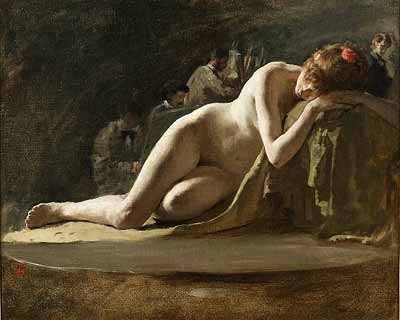
Luigi Loir was a Parisian artist who primarily captured the Belle Epoch in all its glory. For anybody nostalgic about this period in Paris’ history, Luigi should hold a great deal of appeal.
Occasionally Loir painted scenes from other parts of France. ArtGraphicA has a short exclusive art lesson, that imitates one of Luigi Loir’s oil paintings and attempts to replicate some of the feel, using vine charcoal. One of his signature trademarks, is in using wet rainy settings to draw attention to the street, and all the textures and reflections that exist in such an urban setting. To follow the tutorial, please see: Sketching an Urban Landscape.
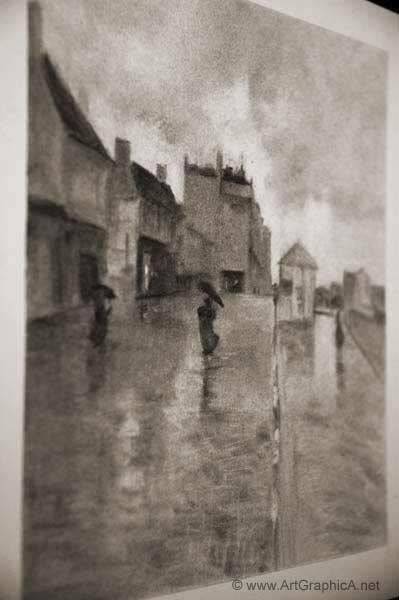
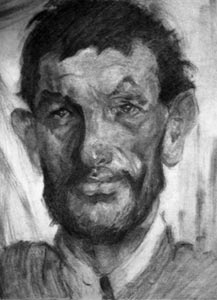 A newly released, exclusive tutorial following in the footsteps of Nicolai Fechin. This art lesson is carried out primarily in vine charcoal, with the use of paintbrushes to help push the dust around and create a more painterly style of drawing. Whilst it’s not quite the same as painting, it does help merge the two disciplines and allows for more play on edge work to create a little more of that painterly style.
A newly released, exclusive tutorial following in the footsteps of Nicolai Fechin. This art lesson is carried out primarily in vine charcoal, with the use of paintbrushes to help push the dust around and create a more painterly style of drawing. Whilst it’s not quite the same as painting, it does help merge the two disciplines and allows for more play on edge work to create a little more of that painterly style.
To view the step-by-step study, please follow this link : Drawing after Fechin.
Sometimes drawing and observation alone isn’t enough, you have to understand the mechanics of what lies beneath. By understanding natures’ design, from bones through to muscles, the skilled artist can portray so much more. It is with this premise in mind that Edwin Noble presents his book on animal drawing and anatomy. Sketching animals in repose, sometimes risks a stiff look. It is important to capture the gesture and kineticism of animals in motion so as not to draw an animal that looks like it was stuffed and mounted on display. By combining the gesture with more detailed study, the artist stands to improve their ability in drawing not only animals, but almost anything they put their hand to.
This unabridged art book covers many subject matters, most of which are common and found close to hand, from dogs and sheep to cows, birds and horses. The last chapter looks at wilder and more exotic animals, that most people would find easier to study at their local zoo.
Looking for something slightly gothic, creepy and macabre to place on your desktop, then try our latest wallpaper from the Sedlec Ossuary near Prague. Available in eight different sizes.
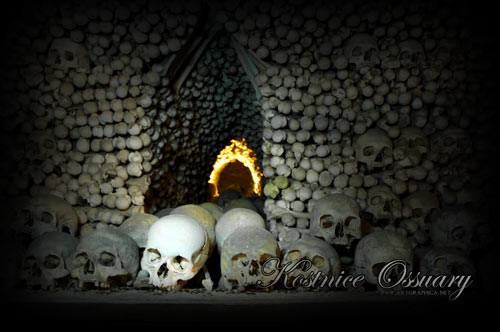
Click here: CHURCH OF BONES WALLPAPER
Frantisek Rint was a wood carver commissioned by the Schwarzenberg family to create pieces of art from the thousands of bones found in the ossuary. Not only did he create the huge ‘bone bells’ as shown in the wallpaper above, but chalices, the Schwarzenberg family coat of arms, and a chandelier featuring every bone found in the human body.
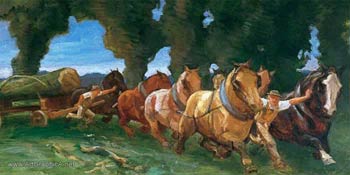 Today we’ve published a book on horse art, specifically dealing with the movement of horses, by the English artist Lowes Dalbiac Liard. Luard is a slightly neglected artist. When we think of horses and art, often names like Degas, or Stubbs, jump to the forefront. Luard was however well known in his day, creating sketches of horses at the Front in the First World War (he was later made an Official War Artist in 1939), capturing such scenes as the Percheron gun teams, fighting not only the enemy, but against the mud in which they were frequently bogged down in.
Today we’ve published a book on horse art, specifically dealing with the movement of horses, by the English artist Lowes Dalbiac Liard. Luard is a slightly neglected artist. When we think of horses and art, often names like Degas, or Stubbs, jump to the forefront. Luard was however well known in his day, creating sketches of horses at the Front in the First World War (he was later made an Official War Artist in 1939), capturing such scenes as the Percheron gun teams, fighting not only the enemy, but against the mud in which they were frequently bogged down in.
He spent thirty years of his life in Paris, watching the Percheron horses work down at the banks of the Seine before machinery took over.
Although the camera was well in use by artists of the time, Luard shunned their use, and felt they failed to capture the sense of movement and action, that might be seen by the trained eye.
This is not a book to teach the painting and drawing of horses in a step-by-step fashion, but with its many illustrations, it teaches how we might better observe these majestic animals, and capture their dynamic movements and rhythms so they may come alive in our own works of art.
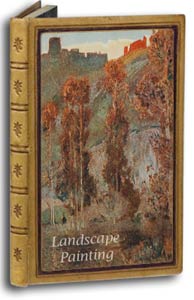 Released today is an unabridged art book on landscape painting by Alfred East. The book starts by acknowledging that technical proficiency does not necessarily go hand-in-hand with producing beautiful works of art. The second chapter, painting nature, is all about the artists’ attitude towards nature, and being able to paint with authority. It is recommended that paintings are built from broad masses, working all areas at the same time, like a musical conductor keeping the orchestra in check. It is recommended that you take to studying daily – if you draw and paint a tree or sky every day, after several months your understanding will increase significantly.
Released today is an unabridged art book on landscape painting by Alfred East. The book starts by acknowledging that technical proficiency does not necessarily go hand-in-hand with producing beautiful works of art. The second chapter, painting nature, is all about the artists’ attitude towards nature, and being able to paint with authority. It is recommended that paintings are built from broad masses, working all areas at the same time, like a musical conductor keeping the orchestra in check. It is recommended that you take to studying daily – if you draw and paint a tree or sky every day, after several months your understanding will increase significantly.
Painting materials covers not only what essential art tools to bring along with you, but also the practicalities of seating, and facing the elements.
Sketching from nature involves being out in the field, and warns on the dangers of painting the middle-ground in landscapes. There is the risk that the same colours as the foreground are used merely with an addition of white, whereby what the artist actually requires is not only change of pigment, but a fresh combination of colour.
Pencil Drawing from nature is about using a sketchbook and pencil to capture your scenes, and should be done so on a daily basis. Scales and exercises are to the pianist as pencil drawings are to the artist.
Art Composition is all about the arrangement of forms upon your canvas. Although it is easy to see examples of bad composition, creating good compositions is not an easy task. Beware of creating equal quantities of light and dark, and take note of repetitions in nature that may lead to your landscape painting being left somewhat bland.
What is colour? asks the philosophical and scientific question that is hard to define precisely. We call yellow, yellow, yet there are thousands of variations of yellow out there with no conventional names.
Painting trees covers the essential topic that no landscape painter can forego. It is only by drawing many different types of trees on a regular basis, that the artist can begin to appreciate and understand them. The correct lighting and modelling of trees involves seeing their rounded nature, so as to avoid flat tones, and the use of edges against the sky.
From trees to painting the sky – If you have the motivation and discipline to paint a sky every morning, within six months you will understand more about its variations. Half an hour a day is all that is required, and to spend longer will lead to frustration as skies are dynamic and change constantly. This chapter also covers a sky palette to achieve blues that are not too dominate or overpowering.
Painting grass acknowledges that painting every blade would be tiresome and stupid. Grass is composed of many shades of green and can appear differently due to reflection, and perspective, depending how close or far away it may be. Weeds and other plants also add to the variations in green. It is important to paint grass as a mass; the author provides a suitable palette for doing so.
Painting reflections covers not only reflections in water, but other elements such as the roofs of houses, that may bounce light in such a manner as to become the most brilliant area in a painting. Grass reflects, and may change the shadows of a cow, or change the colours of a tree trunk.
Distance in painting examines landscape painting from afar. The light in Britain differs greatly from that in Italy, and such atmospheric changes should be represented in your art, and within your palette.
The last chapters cover what to paint and plein air painting, championing the cause of painting directly from nature.
Drawing for beginners is a free online art book, which although slightly dated, offers timeless advice for those wishing to learn how to draw.
Everybody has to start somewhere, and for the enthusiastic beginner, passionate yet overwhelmed by the enormity of the task in front of them, it is often hard to know where to start. The subject of art is a huge undertaking, and for the self-taught artist, creating a structured approach is far from simple. Many aspiring artists long to delve straight into a medium like watercolous or oil paints, but it is important to begin with a humble pencil, or stick of charcoal as a strong foundation and base in which to grow and evolve.
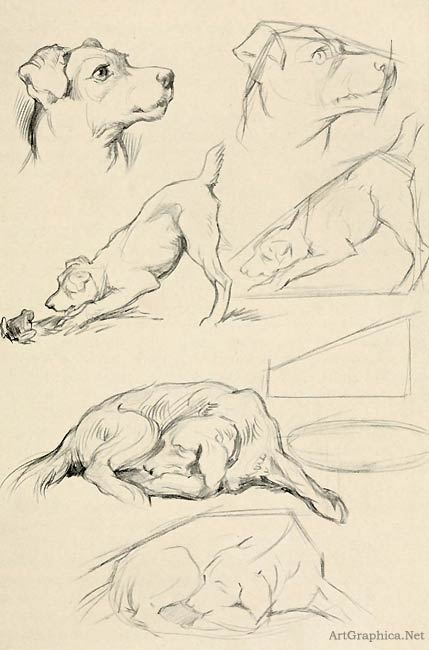
Dorothy Furniss’ book on drawing for beginners is a great starting point in which to gain a broad understanding of many of the basic concepts, championing the simplicity of a pencil from the very start, though also discussing other media, such as drawing with a brush (which should appease those wanting to delve into various media associated with painting), and the use of charcoal, which although oftentimes messy, is an extremely useful medium for beginner and experienced artists alike.
Drawing for beginners will engage the reader, and get them to attempt drawing many household objects of various textures, shape and design. How does one draw the lightness of a feather, and the hardness of a rock, when using the same pencil on a two dimensional sheet of paper? These practical experiments offer the art student interesting challenges, and immediately engage the brain into a dialogue with itself in a way that allows the student to not only visualise the world around them, but question what it is to actually see. There is a little of a scientist and philosopher in all artists.
The book does cover some difficult areas, in fact some of the most challenging any artist may face. Such an example is the chapter on drawing hands which comes early on. Many of the old masters were critiqued by their ability to draw and paint hands as an assessment of their art skills. Students should not judge themselves too harshly, for if you can draw a realistic and well proportioned hand then you have probably spent several years honing your drawing skills already. Feet and faces also provide similar challenges.
For the animal lovers, there is a chapter dedicated to drawing pets, with the great, if not obvious, piece of advice that recommends drawing animals when they are at rest! As with previous chapters, Dorothy does encourage the student to consider the anatomy that lies beneath the skin as this ultimately gives wildlife its form.
If the art student is despondent with their drawings, it may be prudent to jump ahead to the chapter on measuring and perspective. There are some great drawing tips to be learn, from how to measure with a pencil, checking lines with a plumbline and basic issues with perspective, demonstrating one, two and three point perspective, showing horizons and vanishing points.
Sketching outdoors for the beginner artist is a very positive way of improving our vision, and to continue the philosophy of analysing the visual world around us, in ways that photographs cannot. That is not to imply photographs are bad or do not have their uses, but light, form, depth and edges in nature have a subtlety that cannot be observed by anything other than direct observation. Sketching also forces the art student to work quickly and not worry about trying to finish an entire drawing, and such regular studies lead to swifter and greater development.
The very last chapter of the art book looks at correcting drawings. As a beginner sometimes the most obvious mistakes are not at all apparent, and can hold us back in improving our proportions. When drawing a portrait, often the eyes get too much attention and appear too large for example. Asking a second opinion can be useful, but perhaps one of the simplest tricks is to take a mirror and look at your drawings in reverse. When working on a piece it is hard to remain objective and to see what you have done with fresh eyes. The mirror gives you a chance to do just that, and any distortions are usually picked up quickly.
View the book here : DRAWING FOR BEGINNERS
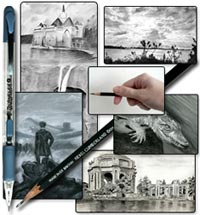
Regular visitors may have noticed a few recent changes to the ArtGraphica website. The Eiffel Tower theme has remained throughout, so chosen because I have been fortunate enough to live in Paris, within walking distance of the tower and art galleries for a number of years.
The categories of art (based on media) should hopefully make each section more distinguished, along with an improvement to the general navigation of the site, including breadcrumbs, improved right-hand side colour coded buttons and some new navigational icons.
There is a “brand new” section to the site on improving drawing and sketching skills, entitled Learn to Draw, for beginner, intermediate and advanced artists. I have to emphasise – brand new – in quotations because these lessons, along with the videos that accompany some of them, actually date back to 2004, when I was still a young whippersnapper of an aspiring artist, with a lot more free time on my hands. Whilst there is a great deal I would add and change to some of the lessons now, I still hope it will proves useful to those wishing to learn art.